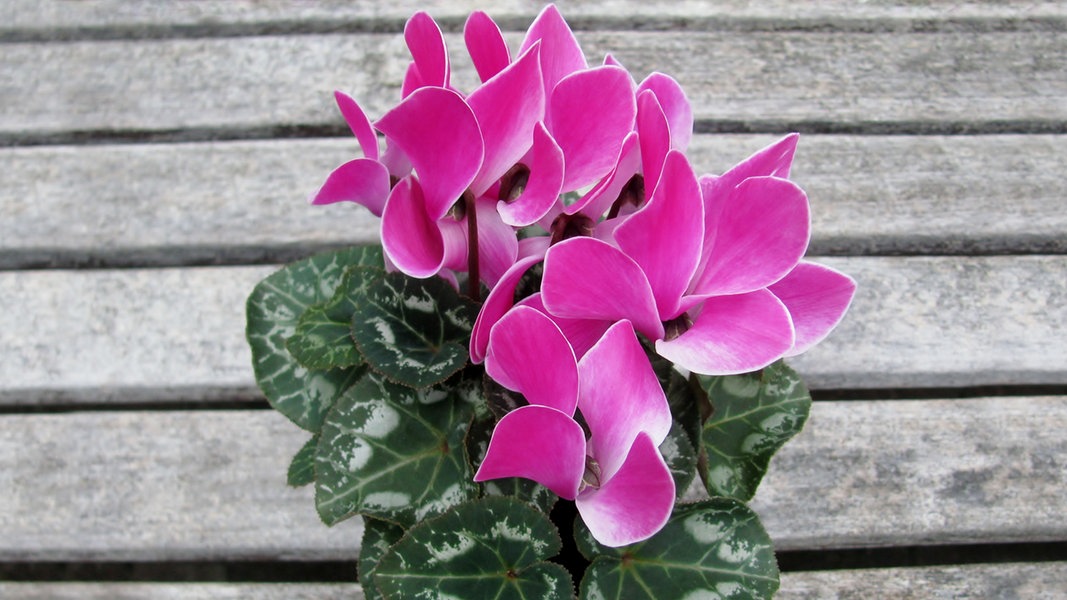As of: January 10, 2024 3:22 p.m
Cyclamen was long considered old-fashioned. There are many pretty varieties. Important to know: Many plants are only suitable for indoors, hardy species can grow in the garden. Tips on care.
For many years, red-flowering cyclamen varieties were in particular demand, but now more playful flowers are in vogue: pastel-colored, two-tone flowers, wavy shapes, flamed types or even flowers with a silvery edge. The richly flowering mini cyclamens are also popular because they often have a delicate scent.
Cyclamen species for indoors and outdoors
When purchasing, you should find out exactly whether the plant is suitable for indoors or outdoors. Indoor cyclamens (Cyclamen persicum) only survive indoors in winter, but can be left outside in a partially shaded place from mid-May. Hardy species (Cyclamen coum, Cyclamen purpurascens and Cyclamen hederifolium) can grow in the garden all year round. Botanically, cyclamen belong to the primrose family.
Water indoor cyclamen correctly
Indoor cyclamens like it bright and rather cool.
Indoor cyclamen blooms from September to April. The small tuberous plant feels comfortable in a bright, not too sunny place that can be a little airy and likes it cool: in winter the temperature should not exceed 15 to 18 degrees. Keep the cyclamen only moderately moist and water it with stale, preferably lime-free water. It’s best to pour the water into the coaster and empty it again after half an hour. Otherwise root rot can easily occur. This in turn increases the susceptibility to pests such as spider mites and aphids.
Modern breeds tolerate heat better
For several years now, there have been modern varieties that are much more robust and tolerate heat better. With luck they will bloom all winter long. When purchasing, pay attention to firm growth. Soft, over-fertilized plants are more susceptible and tolerate room temperatures more poorly. In March, the amount of water should be reduced and the plant should be placed in a cool, shady place. The reward: years of abundant flowering.
Caring for indoor cyclamen in the pot
Simply remove shriveled flowers and leaves: To do this, press down the dense, heart-shaped foliage with one hand and unscrew the entire stem like a screw. Remove yellow leaves. This creates space for new flowers and prevents the withered parts of the plant from rotting. During the flowering phase, feed the plant with low-dose liquid fertilizer once a week. The plants should then only be supplied with a little fertilizer every few weeks. Repot the cyclamen every two years and provide it with fresh potting soil. Do not plant the tuber deeper than in the previous pot.
Plant hardy cyclamen in the garden
Spring cyclamen usually open their flowers from February onwards.
Hardy varieties can be planted in the garden and brighten up the dreary season. Early spring cyclamen blooms as early as February. They are also well suited as grave plants in autumn. The flowers of the European cyclamen appear in summer, and from August onwards the flowers of the autumn cyclamen appear. The plants are available in selected perennial nurseries, which often also have online shipping.
A semi-shady place under trees is suitable as a location. The garden soil should be permeable to prevent waterlogging. When planting, make sure that the tuber is seven to ten centimeters deep in the soil. Winter protection is recommended in the first few years.
Propagate cyclamen: pollinate the flowers yourself
If you want, you can propagate your cyclamen yourself with a little experiment. To do this, hold your thumbnail under a flower that has fully developed. Lightly tap the flower stem from above with one finger of your other hand. The pollen comes off and lands on the thumbnail. Use the nail to transfer the pollen to another flower that is also fully bloomed. After a few days, the pollinated flower withers and the ovary swells into a small ball.
Harvest seeds and sow in potting soil
At the same time, the flower stalk begins to twist up in a spiral and hide under the leaves. Later, the ripe fruit bursts open and the small, knobby seeds can be harvested. Place these in potting soil and cover with a 0.5 centimeter thick layer of soil. Then place the container in a dark and warm place, because cyclamen are “dark germs”. With a bit of luck, the seeds will have germinated after about four to six weeks. It takes at least 31 weeks for flowering.
Cyclamen: Toxic to humans and pets
Whether in the garden or as a houseplant, cyclamen are poisonous. If leaves or tubers are consumed, gastrointestinal complaints such as nausea, vomiting or diarrhea can occur, and with larger quantities dizziness and symptoms of paralysis. A doctor should be consulted for both pets and people.
Frequently asked questions about cyclamen
Indoor cyclamens (Cyclamen persicum) are not hardy. However, after the Ice Saints in May until autumn, they can be kept in a semi-shady location in the garden. If you want the cyclamen to grow in the garden all year round, winter-hardy species are suitable.
If you want to plant cyclamen in your garden permanently, you should choose a hardy species. Early spring cyclamens (Cyclamen coum) bloom in February and March but require winter protection until then. European cyclamen (Cyclamen purpurascens) blooms in July and August,
Ivy-leaved cyclamen (Cyclamen hederifolium) from around August to October.
The soil of indoor cyclamen should be kept moderately moist during the flowering phase. Lime-free water that is poured into a saucer is best. The soil in the garden should be moderately moist and there should be no waterlogging.
Further information
30 Min
Autumn has more to offer than mud in the garden. Some plants can still form colorful blobs of color, which we reveal from an English garden in Gelting. 30 min
Brown or affected leaves: What causes houseplants to become sick in winter? Tips for optimal care. more
This topic in the program:
Quickly through the garden | November 6, 2023 | 9:00 p.m
